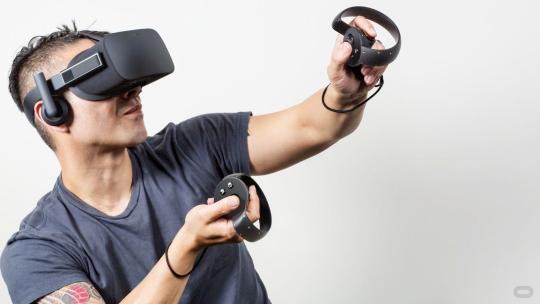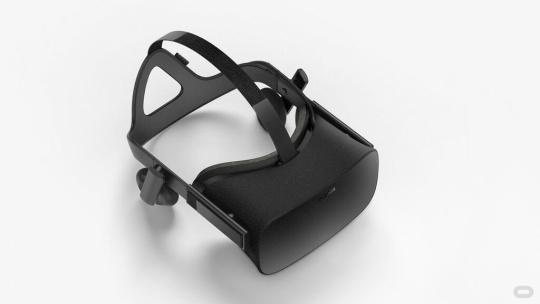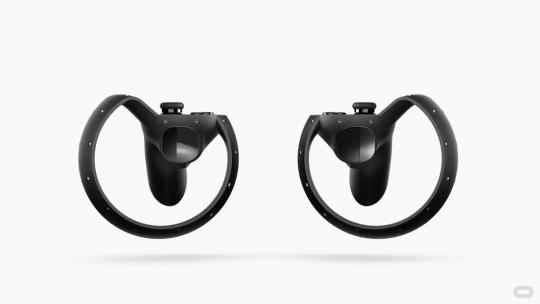
The virtual future is almost here, and it looks pretty comfy.
During a press conference in San Francisco on Thursday, Oculus revealed that its anticipated Rift headset will officially be available in Q1 2016. No price was announced, but the company did show off the final retail version of the hardware and a handful of new features.
Virtual comfort
After years of clunky prototypes, Oculus has streamlined the Rift into something that might not be totally embarrassing to strap to your head. The headset features a custom display and optics system, two fancy organic light-emitting diode (OLED) screens, and removable headphones.
“It feels like you’re wearing a pair of glasses,” said Oculus CEO Brendan Iribe.

For that matter, it’s been designed to work with the glasses you already wear. A little dial lets you adjust the lens distance to make sure it’s centered, and the whole thing is wrapped in what looks like a soft fabric.
A newly announced sensor will help the Rift will track your position in space while wearing the headset. The small, lightweight sensor plugs into your computer and sits on your desk. Are you standing up? Seated? Downward Dog? The sensor will track that to keep you immersed in the virtual environment.
Virtual controls
Oculus also answered some pressing questions about how exactly one might navigate in VR. The answer? Call Microsoft.
Every Oculus will ship with a wireless Xbox One gamepad. The Rift will also work natively with Windows 10. You’ll even be able to stream Xbox One games from your console to the Rift (hooked up to a PC), which will emulate sitting in your living room and playing your Xbox One on a huge screen. Not exactly a breakthrough, but I suppose if your household is fighting over the TV, this would provide a solution. It’s an interesting partnership, particularly in light of Sony’s competing Morpheus headset, which will work only with the PlayStation 4. Touché!

But Oculus didn’t stop there. Company founder Palmer Luckey trotted onstage to introduce Oculus Touch, two wireless, hoop-shaped controllers you hold in your hands that let you interact with virtual objects in a more natural way than nudging a stick on a gamepad. It’s essentially Oculus’s take on the Wii Remote or PlayStation Move, and while the Touch looks cool, Oculus didn’t announce a price or release date.
Virtual fun
So what will you be playing on the Rift? A few things, at least.
Impressive space dogfighting game Eve: Valkyrie, moody role-playing game Chronos, and a third-person action game set in the arctic calledEdge of Nowhere were demoed on stage. Five other games were announced as being available alongside the Rift when it ships.
Oculus is also investing $10 million to support independent developers making games for the Rift, which may help the company score a few more exclusive games before the device ships.
As for how you’ll actually manage your Rift gaming, that’s left to Oculus Home. The main hub for Oculus games can be accessed directly from the headset and includes a storefront, game info, and user ratings. You’ll also be able to preview games before you buy them. If you prefer to do all of that in a more traditional 2D space, that’s supported as well via a Home website, which you can access from any computer.
Real-world issues
All of this is well and good, but what’s the cost of entry? Oculus has been dodging that one for years, in part because getting a Rift working will be pricey.
According to Luckey, if you already own a good gaming rig, you won’t need a new computer and can expect to pay between $200 and $400 for the headset. But don’t expect your fancy MacBook to do the job. Not only is it not powerful enough, but also at launch, the Rift won’t support Mac or Linux.
That means a fair share of us will have to get a new computer, too, and that’s where the Rift becomes a scary purchase. A few weeks back, Iribe noted that an “all-in” price — in other words, the Rift headset and a computer powerful enough to handle VR gaming — would be in the neighborhood of $1,500. Is virtual realty worth the reality of credit card debt?
The Rift faces stiff competition in the VR space. Sony’s Morpheus is expected to be released next year, and since it works with a PS4, it’s likely to be significantly more affordable to get up and running. Though it will also likely cost a bazillion dollars, Valve’s impressive Vive VR system has pretty much floored the lucky few who have experienced it. Microsoft’s putting a lot of time and effort into its HoloLens device, which blends virtual and augmented reality. Oculus is still in the VR driver’s seat, but the race is getting tighter.
The Rift will be out in force at the huge E3 video game conference in Los Angeles next week. Expect some hands-on, er, face-on, impressions.
No comments:
Post a Comment